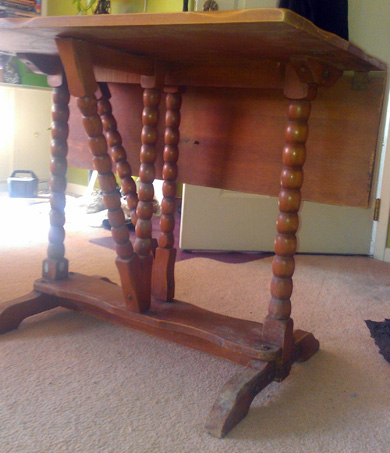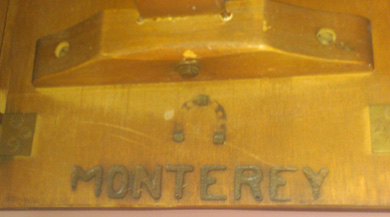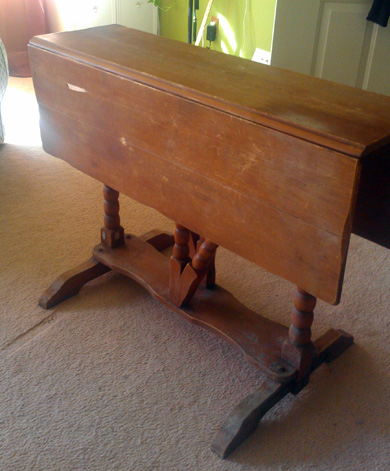 |
|
|||
 |
 |
|||
RINKER ON COLLECTIBLES — Column #1459 Copyright © Harry Rinker, LLC 2014 Questions
and Answers
QUESTION: I recently acquired a Monterey drop leaf, turned leg table for $35.00 at an estate sale. I want to paint it over and use it as a window table for plants. Of course, if it has a high value, I probably should not do that. I love the table regardless of its value. What is your advice? – TB, Roswell, NM, Email Question
ANSWER: “Monterey” is a brand or product line name used by several 1930s to mid-1940s California furniture manufacturers to designate furniture that consisted of a mixture of furniture design styles including California Mission, Dutch Colonial, Spanish Colonial, and Western ranch house. Decorative motifs often featured western images. Angeles Furniture Company, Brown and Saltman, Del-Ray, Imperial Company, and Mason Manufacturing Company were among the leading manufacturers. Even Sears and Stickley developed “Monterey” lines. Imperial’s Monterey favored mahogany, often with a simple brown finish. Mason’s Monterey favored Oregon alder. Much of Mason’s early Monterey furniture was painted in a bright, festive Mexican motif. See http://en.wikipedia.org/wiki/Monterey_Furniture for a detailed history of Monterey style furniture.
Research confirmed that the ‘MONTEREY’ and horseshoe mark on your Spanish Revival style drop leaf table is that of the Mason Manufacturing Company. eBay has a listing for a fully restored table identical to the one you own listed. The eBay seller is asking $1,500.00. The table measures 39 inches long by 35 1/2 inches wide, by 30 inch high. When closed the table is 11 1/4 inches wide. Whether you should or should not paint the table depends entirely on what answer best serves you. When I saw the pictures that accompanied your email and learned what you paid, my first reaction was to advise you to restore the table to its original finish and exercise care when using it. Unfortunately, this means keeping the table out of the sunlight. Sunlight acts as a bleach and will fade the finish. Covering the table with a runner will not solve the problem. Do not be fooled by the $1,500 eBay dealer’s asking price. This price is unrealistic, except perhaps to Hollywood interior decorators whose clients have no concern about the amount of money their decorator spends. A refinished table, outside of the California Hollywood and suburban city market, has a value between $300.00 and $350.00. If you insist on using the table for a “window table” for plants, then paint it. The paint will protect what is left of the period finish. As some future point, another individual may purchase the table and decide to restore it – that owner’s choice but not yours.
QUESTION: I have an Illinois “Reading Railroad” pocket watch. It has an open face, large numbers, 21 jewels, and a gold filled case. There is a relief of an engine on the back. “Reading Railroad” is etched on the glass cover. How does a “railroad” pocket watch differ from a regular pocket watch? What is the value of my watch? – G, Reading, PA ANSWER: A railroad watch (or chronometer) is a specialized type of pocket watch. The railroad watch was/is a critical tool of railroad employees such as engineers, conductors, and others who ensured that trains operated on an accurate and dependable time schedule. Railroad companies employed “time inspectors,” often a watchmaker, to select and maintain the watches used by the railroad personnel. Initially, each railroad set its own standards for the railroad watch. In 1887, the American Railway Association held a meeting and set standards. Again, not all railroads adopted them. Webb C. Bell, whose career included being the time inspector for more than half the American railroads, was a leader in pushing for uniform standards. While American watch manufacturers were producing railroad standard watches as early as the 1850s, the standard in 1890 was an 18-size, 15-jewel, three position adjustment watch. Dueber-Hampden introduced an 18-size, 17 jewel railroad pocket watch in 1891. The same year Illinois introduced a 16-jewel Bunn high grade watch. Waltham introduced its 17-jewel Vanguard Model ’92 a year later. By the end of the 1890s, 21-jewel watches were common. As the 21st century began, the small 16-size became favored over the 18-size railroad pocket watch. The standard requirements for an American railroad pocket watch divide into two groups: (1) obvious and (2) technical. The obvious are: (a) American made, thus assuring a ready availability of spare parts for repair; (b) open face with the stem set at 12 o’clock; (c) white face with bold Arabic numerals denoting hours and minutes, (d) lever not stem set, thus avoiding inadvertently setting the time when winding the watch; (e) 16 or 18 size; and (f) 17 or more jewels. These obvious characteristics can be spotted by the most novice watch collectors. The technical features can be learned. However, given the wide variety of movements, study is required. Technical features include: (a) maximum 30 second variations in time; (b) minimum of five adjustments positions: (c) adjustment for severe temperature changes; (d) Brequet balance spring; (e) micrometer adjustment [patented] regulator, (f) double roller escapement; and (g) steel escape wheel. Most railroad watches that appear in the secondary market were manufactured in the 20th century. Following World War II, railroad pocket watches added anti-magnetic protection, the result of the introduction of diesel-electric locomotives. Ball, Elgin, Hamilton, Illinois, Rockford, South Bend, and Waltham were leading manufacturers who produced railroad watches. Each continually improved the quality of the working mechanism. When valuing a watch, it is critical to identify the Model number. Help is available from the members of the National Association of Watch & Clock Collectors (http://www.nawcc.org/). Contact the organization for the name of a member living near you. The NAWCC’s museum is located in Columbia, Pennsylvania, a short drive from your home in Reading. For more information, see: http://ph.nawcc.org/Railroad/Railroad.htm and http://en.wikipedia.org/wiki/Railroad_chronometer. You did not specify whether or not your Illinois “Reading Railroad” watch worked. I am going to assume that it does. The case is gold-filled, meaning there is minor but not significant melt gold value in the case. The 21-jewel count is high. The engraved glass is a major plus, especially since the watch is located in the area in which the railroad operated. Although I found asking prices for Illinois Bunn Special railroad pocket watches ranging on eBay from $500.00 to close to $2,000.00, most fell within the range of $500.00 to 700.00. These are asking prices and not selling prices. Conservatively, your Illinois “Reading Railroad” pocket watch has a value between $450.00 and $550.00 QUESTION: As a youngster in the mid-1980s, I played the “Fireball Island” game. I recently acquired a copy for $75.00. In researching the game on eBay, I found asking prices listed at $300.00 and more. Is the game really worth $300.00? – S, State College, PA ANSWER: Antiques and collectibles value is momentary, not fixed. At the time you acquired the game, it was worth $75.00, the price you paid. A seller can ask any price he or she wants. However, the object has no value until it is sold. Will the eBay dealer be able to obtain $300.00 for the game – maybe and maybe not? According to www.boardgamegeek.com, one of the best Internet sources for the history of board games, Chuck Kennedy and Bruce Lund designed the Fireball Island game for Milton Bradley. The game was first released in 1986. In addition to its American release, the game also was issued in Canada, France (1987), Italy, Netherlands (1989), and Spain. The game had a large number of parts: (1) a three-dimensional plastic game board; (2) a manual: (3) red die; (4) 48 playing cards; (5) blue, purple, yellow, and red explorer figures; (6) a three-piece Vul-Kar Idol; (7) five red 5/8 inch marbles: (8) a red jewel; (9) four magic charm tokens; and (10) four bridge pieces, signifying a game opportunity or take away. This list will help you determine if the game you purchased is complete. I looked at eBay. Prices for the game ranged from under $50.00 to over $400.00. One eBay dealer is selling the parts. The dealer most likely found an incomplete game and hopes to achieve more by selling the remaining parts separately than in a lot. As toys from a new decade, such as the 1980s, first enter the secondary market, there is a group of buyers whose primary interest is acquiring a copy of the toy they remember from their youth. This buying group is impatient and not market savvy. When the desire to acquire strikes, they want instant gratification. They are prepared to pay whatever it takes. Sophisticated dealers know this and have no problem taking advantage of a buyer’s naiveté. As a result, some sales occur at three to ten times the “true” worth of the game. The secondary market is a speculative one for many 1980s and early 1990s toys. The dust will settle in five or ten years, at which point a stable, dependable secondary market price will establish. Further, as the generation that played with Fireball Island ages past 55 years, prices will fall steadily. The value of this game is one-generational. In 2050, only a handful of people will remember it and chances are strong that they will no longer care.Harry L. Rinker welcomes questions from readers about
collectibles, those mass-produced items from the twentieth and twenty-first centuries.
Selected letters will be answered in this column.
Harry cannot provide personal answers.
Photos and other material submitted cannot be
returned.
Send your questions to: Rinker on Collectibles, 5955 Mill
Point Court SE, Kentwood, MI 49512.
You also can e-mail your questions to
harrylrinker@aol.com.
Only e-mails containing a full name and mailing address
will be considered.
You can listen
and participate in
WHATCHA GOT?, Harry’s
antiques and collectibles radio call-in show, on Sunday mornings between 8:00 AM
and 10:00 AM Eastern Time.
If you
cannot find it on a station in your area,
WHATCHA GOT?
streams live on the Internet at www.gcnlive.com.
SELL, KEEP OR TOSS?: HOW TO DOWNSIZE A HOME,
SETTLE AN ESTATE, AND APPRAISE PERSONAL PROPERTY
(House of Collectibles, an imprint of Random House Information Group, $17.99),
Harry’s latest book, is available at your favorite bookstore and via
www.harryrinker.com.
|
||||


